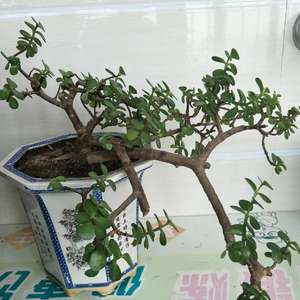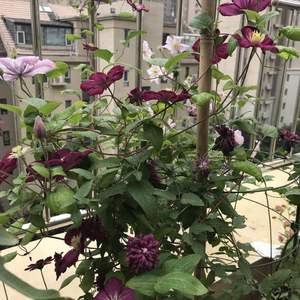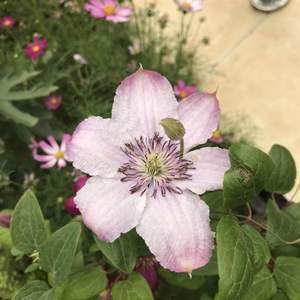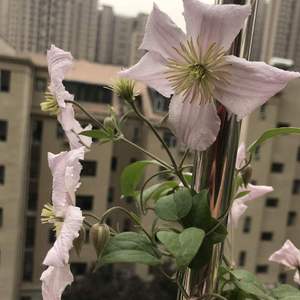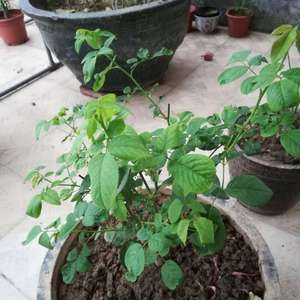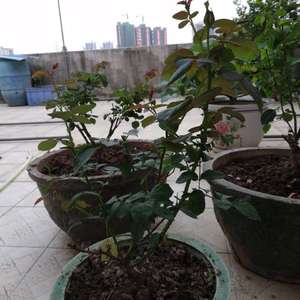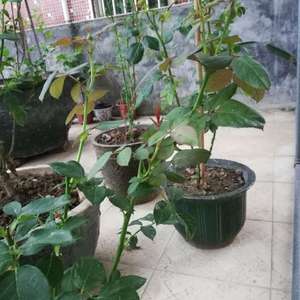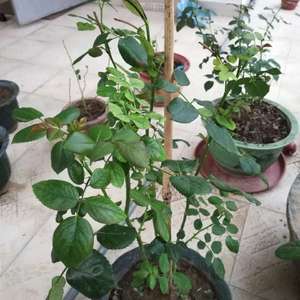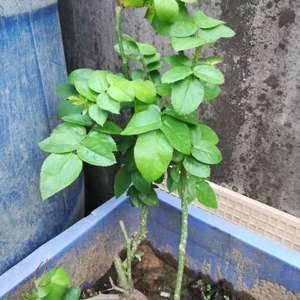文章
Miss Chen
2018年06月25日

Description: This herbaceous perennial wildflower is about 1-2' tall. Alternate compound leaves occur primarily along the lower half of each hairy stem. These leaves are odd-pinnate; they are up to 8" long and 2" across. The lower leaves have 5-7 leaflets, while the sessile upper leaves have 3 leaflets. The terminal leaflet is much larger than the lateral leaflets. The leaflets are coarsely serrated, slightly hairy, rough-textured, and medium green; the terminal leaflet is sometimes divided into 3 lobes. In addition to these leaflets, the lower leaves have tiny secondary leaflets that are inserted between the lateral leaflets.
The upper stems terminate in nodding cymes of flowers. The branches of each cyme are dark purple and very hairy. Each flower is ¾–1" across, consisting of 5 dull red to pale purple petals, 5 dark purple sepals, numerous stamens with yellow anthers, and numerous pistils in the center. Sometimes the inner sides of the petals are pale yellow; regardless of color, they are conspicuously veined. The hairy sepals are ovate in shape; they are about as long as the petals. Between each pair of sepals, there is a linear bract that is dark purple and hairy. The blooming period occurs from late spring to mid-summer and lasts about 1-2 months. Each pistil is replaced by a flattened achene with a long persistent style; the style is hooked toward its tip and often pubescent. The root system is fibrous and rhizomatous. Dense clumps of plants are often formed from the rhizomes.
Cultivation: The preference is partial to full sun, wet to moist conditions, and cool to mild summer temperatures. Various kinds of soil are tolerated.

Range & Habitat: Water Avens is restricted to northern Illinois, where it is rare and native (see Distribution Map). Because this species has not been observed in natural areas of the state for several decades, it may be extirpated because of destruction or degradation of habitat. Water Avens has a circumboreal distribution in North America, Europe, and Asia; northern Illinois lies at its southern range limit. Habitats include White Cedar fens (in Kane County), bogs, marshes, and soggy meadows. This species is sometimes cultivated in gardens.
Faunal Associations: According to Mueller (1873/1883), the flowers produce both nectar and pollen; they are pollinated primarily by bumblebees. Mueller also observed honeybees, long-beaked Syrphid flies (Rhingia sp.), and Sap beetles (Nitulidae) visiting the flowers for nectar or pollen. Because the achenes have persistent styles with hooked or jointed tips, it is possible that they are distributed by birds or mammals.
Photographic Location: A flower garden at the University of Illinois Arboretum in Urbana, Illinois.
Comments: This is one of the more showy species in the genus. Other Geum spp. (Avens) have smaller flowers that are white or yellow. An exception is Geum triflorum (Prairie Smoke), which has nodding red to purple flowers. Unlike Water Avens, the petals of Prairie Smoke are mostly hidden by the sepals. The achenes of Prairie Smoke have long plumose styles that are distributed by the wind. In contrast, the achenes of Water Avens have styles that are jointed or hooked; they are probably distributed by animals, as noted above. Prairie Smoke typically occurs in dry gravelly prairies, while Water Avens is found in various wetland habitats. Another common name of Geum rivale is Purple Avens.
The upper stems terminate in nodding cymes of flowers. The branches of each cyme are dark purple and very hairy. Each flower is ¾–1" across, consisting of 5 dull red to pale purple petals, 5 dark purple sepals, numerous stamens with yellow anthers, and numerous pistils in the center. Sometimes the inner sides of the petals are pale yellow; regardless of color, they are conspicuously veined. The hairy sepals are ovate in shape; they are about as long as the petals. Between each pair of sepals, there is a linear bract that is dark purple and hairy. The blooming period occurs from late spring to mid-summer and lasts about 1-2 months. Each pistil is replaced by a flattened achene with a long persistent style; the style is hooked toward its tip and often pubescent. The root system is fibrous and rhizomatous. Dense clumps of plants are often formed from the rhizomes.
Cultivation: The preference is partial to full sun, wet to moist conditions, and cool to mild summer temperatures. Various kinds of soil are tolerated.

Range & Habitat: Water Avens is restricted to northern Illinois, where it is rare and native (see Distribution Map). Because this species has not been observed in natural areas of the state for several decades, it may be extirpated because of destruction or degradation of habitat. Water Avens has a circumboreal distribution in North America, Europe, and Asia; northern Illinois lies at its southern range limit. Habitats include White Cedar fens (in Kane County), bogs, marshes, and soggy meadows. This species is sometimes cultivated in gardens.
Faunal Associations: According to Mueller (1873/1883), the flowers produce both nectar and pollen; they are pollinated primarily by bumblebees. Mueller also observed honeybees, long-beaked Syrphid flies (Rhingia sp.), and Sap beetles (Nitulidae) visiting the flowers for nectar or pollen. Because the achenes have persistent styles with hooked or jointed tips, it is possible that they are distributed by birds or mammals.
Photographic Location: A flower garden at the University of Illinois Arboretum in Urbana, Illinois.
Comments: This is one of the more showy species in the genus. Other Geum spp. (Avens) have smaller flowers that are white or yellow. An exception is Geum triflorum (Prairie Smoke), which has nodding red to purple flowers. Unlike Water Avens, the petals of Prairie Smoke are mostly hidden by the sepals. The achenes of Prairie Smoke have long plumose styles that are distributed by the wind. In contrast, the achenes of Water Avens have styles that are jointed or hooked; they are probably distributed by animals, as noted above. Prairie Smoke typically occurs in dry gravelly prairies, while Water Avens is found in various wetland habitats. Another common name of Geum rivale is Purple Avens.
0
0
文章
Miss Chen
2018年06月21日

Description: This perennial plant is 1-4' tall. It is erect and usually remains unbranched. The central stem is light to medium green, terete or angular, and glabrous to sparsely hairy. The alternate leaves are up to 5" long and 2" wide; they are oblanceolate, obovate, ovate, or broadly elliptic in shape, and their margins are serrated. The lower leaves clasp the central stem, while the upper leaves are sessile. The upper surfaces of leaves are medium to dark green and sparingly covered with short hairs. The central stem terminates in a spike-like raceme of flowers about ½-2' long.
The flowers are 1-1½" long, angled upward, and densely distributed along the raceme. Each flower has a blue-violet corolla (rarely white) that is narrowly bell-shaped (campanulate) and 2-lipped. The upper lip has 2 slender erect lobes that curve slightly inward or backward, while the lower lip has 3 descending lobes that are oblong-lanceolate. Near the throat of the flower at the base of the lower lobes, there is a pair of small white patches. The green calyx is deeply divided into 5 linear-lanceolate teeth; it is conspicuously hairy. The calyx teeth are long and spreading. The blooming period occurs from late summer into fall, lasting about 2 months. Afterwards, the flowers are replaced by capsules containing small seeds. These seeds are probably distributed by wind or water to some extent. The root system consists of a central taproot, fromDistribution Map which occasional basal offshoots are produced.
Cultivation: The preference is wet to moist soil and partial sun. Full sun is tolerated if the soil is consistently moist, and light shade is also acceptable. The soil should be fertile and loamy. This plant withstands occasional flooding, but it will become muddy and ragged-looking if it receives too much abuse. The small seeds require light to germinate. Great Blue Lobelia can be highly variable in height, depending on environmental conditions and its stage of development.
Range & Habitat: The native Great Blue Lobelia occurs throughout Illinois, except for a few counties in southern Illinois. It is occasional to locally common. Typical habitats include moist black soil prairies, soggy meadows near rivers, low areas along rivers and ponds, floodplain and bottomland woodlands, woodland borders, bottoms of sandstone canyons along streams, swamps, fens, gravelly seeps and springs, ditches, and moist areas of pastures. Great Blue Lobelia can be found in both disturbed areas and high quality habitats.
Faunal Associations: The nectar and pollen of the flowers attract primarily bumblebees and other long-tongued bees (Anthophora spp., Melissodes spp., Svastra spp.). Less common visitors include the Ruby-Throated Hummingbird, large butterflies, and Halictid bees. The Halictid bees collect pollen only and they are non-pollinating. The caterpillars of a moth, Enigmogramma basigera (Pink-washed Looper Moth), feed on the foliage of Great Blue Lobelia (Schweitzer & Roberts, 2007). Most mammalian herbivores don't eat this plant because the foliage contains several toxic alkaloids, chief among them being lobeline and lobelanine. These toxic substances produce symptoms that resemble nicotine poisoning. However, it has been reported that deer occasionally eat this plant, perhaps enjoying greater immunity to these toxic substances than other animals. The seeds are too small to be of much value to birds.
Photographic Location: The photographs were taken at a garden of the Anita Purves Nature Center in Urbana, Illinois.

Comments: Great Blue Lobelia is a lovely plant that produces some welcome diversity with its violet-blue flowers during late summer or fall, when forbs with yellow flowers are typically dominant. Unfortunately, its value to wildlife is rather limited. Among the Lobelia spp. with bluish flowers in Illinois, Great Blue Lobelia has the largest flowers and they are usually a more deep shade of blue-violet, making it easy to identify.
The flowers are 1-1½" long, angled upward, and densely distributed along the raceme. Each flower has a blue-violet corolla (rarely white) that is narrowly bell-shaped (campanulate) and 2-lipped. The upper lip has 2 slender erect lobes that curve slightly inward or backward, while the lower lip has 3 descending lobes that are oblong-lanceolate. Near the throat of the flower at the base of the lower lobes, there is a pair of small white patches. The green calyx is deeply divided into 5 linear-lanceolate teeth; it is conspicuously hairy. The calyx teeth are long and spreading. The blooming period occurs from late summer into fall, lasting about 2 months. Afterwards, the flowers are replaced by capsules containing small seeds. These seeds are probably distributed by wind or water to some extent. The root system consists of a central taproot, fromDistribution Map which occasional basal offshoots are produced.
Cultivation: The preference is wet to moist soil and partial sun. Full sun is tolerated if the soil is consistently moist, and light shade is also acceptable. The soil should be fertile and loamy. This plant withstands occasional flooding, but it will become muddy and ragged-looking if it receives too much abuse. The small seeds require light to germinate. Great Blue Lobelia can be highly variable in height, depending on environmental conditions and its stage of development.
Range & Habitat: The native Great Blue Lobelia occurs throughout Illinois, except for a few counties in southern Illinois. It is occasional to locally common. Typical habitats include moist black soil prairies, soggy meadows near rivers, low areas along rivers and ponds, floodplain and bottomland woodlands, woodland borders, bottoms of sandstone canyons along streams, swamps, fens, gravelly seeps and springs, ditches, and moist areas of pastures. Great Blue Lobelia can be found in both disturbed areas and high quality habitats.
Faunal Associations: The nectar and pollen of the flowers attract primarily bumblebees and other long-tongued bees (Anthophora spp., Melissodes spp., Svastra spp.). Less common visitors include the Ruby-Throated Hummingbird, large butterflies, and Halictid bees. The Halictid bees collect pollen only and they are non-pollinating. The caterpillars of a moth, Enigmogramma basigera (Pink-washed Looper Moth), feed on the foliage of Great Blue Lobelia (Schweitzer & Roberts, 2007). Most mammalian herbivores don't eat this plant because the foliage contains several toxic alkaloids, chief among them being lobeline and lobelanine. These toxic substances produce symptoms that resemble nicotine poisoning. However, it has been reported that deer occasionally eat this plant, perhaps enjoying greater immunity to these toxic substances than other animals. The seeds are too small to be of much value to birds.
Photographic Location: The photographs were taken at a garden of the Anita Purves Nature Center in Urbana, Illinois.

Comments: Great Blue Lobelia is a lovely plant that produces some welcome diversity with its violet-blue flowers during late summer or fall, when forbs with yellow flowers are typically dominant. Unfortunately, its value to wildlife is rather limited. Among the Lobelia spp. with bluish flowers in Illinois, Great Blue Lobelia has the largest flowers and they are usually a more deep shade of blue-violet, making it easy to identify.
0
0
文章
Miss Chen
2018年06月21日

Description: This perennial wildflower is ½-1½' tall and either branched or unbranched. The slender stem(s) is light green to purple. Alternate leaves about ½-2" long and 1-5 mm. across occur along the stem(s). The leaves are light to medium green, linear to linear-oblong in shape, and usually smooth along their margins. The central stem and any lateral stems terminate in racemes of flowers; the flowers are distributed sparsely along the rachis of each raceme. Each flower is ¼-½" across, consisting of a 2-lipped tubular corolla that is light blue (rarely white), a bell-shaped (campanulate) calyx with 5 slender teeth that are light green to purple, 5 stamens, and a 2-celled ovary with a single style. The stamens tightly surround the style. The upper lip of the corolla is divided into 2 small narrow lobes, while the lower lip is divided into 3 large lobes. At the base of the corolla's lower lip, there is a conspicuous patch of white; sometimes this patch becomes yellow along its upper boundary near the throat of the corolla. The corolla is hairless throughout, while sometimes the bottom of the calyx is pubescent. The slender pedicels of the flowers are ¼-1" long; they are light green to purple and either glabrous or minutely pubescent. Toward the middle of each pedicel there is a tiny linear bractlet; at the base of each pedicel there is a linear bract that is about the same length as the pedicel. The blooming period occurs from mid-summer to early fall and lasts about 1 month. Afterwards, the flowers are replaced by seed capsules about 4 mm. across; each capsule splits open at its apex to release numerous tiny seeds that are narrowly oblongoid and compressed (somewhat flattened) in shape. The seeds are small enough to be blown about by the wind or transported by water. The root system is shallow and fibrous.
Cultivation: The preference is full sun, wet to consistently moist conditions, and soil that is sandy to sandy-peaty and calcareous. Episodic periods of shallow water are tolerated.
Range & Habitat: The native Kalm's Lobelia occurs in northern Illinois, where it is uncommon (see Distribution Map). Illinois lies along the southern range limit of this species. Habitats include grassy fens, wet sandy meadows, borders of interdunal swales, low areas along springs, and bogs. This conservative species is found in high quality wetlands where the original flora remains intact.

Faunal Associations: Very little is known about floral-faunal relationships for this species. The flowers are probably cross-pollinated by various bees and small butterflies. Like other Lobelia spp., Kalm's Lobelia has an acrid sap that is more or less toxic to mammalian herbivores.
Photographic Location: A fen in NE Illinois. The photographs were taken by Lisa Culp, Copyright © 2011.
Comments: This is one of the less common Lobelia species in Illinois. Kalm's Lobelia has a delicate beauty that derives from its pastel blue flowers and slender foliage. It is somewhat similar in appearance to Pale-Spiked Lobelia (Lobelia spicata), but its leaves are more narrow (less than ¼" across). Other Lobelia species in the state also have wider leaves, and some species have larger flowers. Another common name of Lobelia kalmii is Brook Lobelia.
Cultivation: The preference is full sun, wet to consistently moist conditions, and soil that is sandy to sandy-peaty and calcareous. Episodic periods of shallow water are tolerated.
Range & Habitat: The native Kalm's Lobelia occurs in northern Illinois, where it is uncommon (see Distribution Map). Illinois lies along the southern range limit of this species. Habitats include grassy fens, wet sandy meadows, borders of interdunal swales, low areas along springs, and bogs. This conservative species is found in high quality wetlands where the original flora remains intact.

Faunal Associations: Very little is known about floral-faunal relationships for this species. The flowers are probably cross-pollinated by various bees and small butterflies. Like other Lobelia spp., Kalm's Lobelia has an acrid sap that is more or less toxic to mammalian herbivores.
Photographic Location: A fen in NE Illinois. The photographs were taken by Lisa Culp, Copyright © 2011.
Comments: This is one of the less common Lobelia species in Illinois. Kalm's Lobelia has a delicate beauty that derives from its pastel blue flowers and slender foliage. It is somewhat similar in appearance to Pale-Spiked Lobelia (Lobelia spicata), but its leaves are more narrow (less than ¼" across). Other Lobelia species in the state also have wider leaves, and some species have larger flowers. Another common name of Lobelia kalmii is Brook Lobelia.
0
0
文章
Miss Chen
2018年06月18日

Description: This perennial plant is 3-5' tall and unbranched, except for flowerhead-bearing stalks near the apex of the plant. The central stem is stout, terete, and either purple-spotted or purple; it is often covered with short fine hairs. At intervals along the central stem, there are whorls of 4-5 leaves that are yellowish green or green. These leaves are up to 7" long and 2½" across; they are lanceolate to broadly elliptic and serrated along their margins. The upper leaf surfaces have conspicuous venation. The petioles of the leaves are short (less than ¼" in length). The central stem terminates in a rather flat-headed panicle of flowerheads spanning 3-6" across. Small clusters of flowerheads may occur below on separate stalks. Each narrow flowerhead is about 1/3" (8 mm.) long, consisting of 8-20 pink to purplish pink disk florets and no ray florets. Each tiny disk floret has a narrowly tubular corolla with 5 spreading lobes along its upper rim; exerted from the corolla, there is a strongly exerted style that is divided into filiform parts. The narrow bracts (phyllaries) at the base of each flowerhead are pink or purplish pink, like the disk florets. The flowering stalks are purple-spotted to purple and they are often covered with short fine hairs. The blooming period occurs from mid- to late summer, lasting about 3-4 weeks. The flowerheads are often fragrant. The florets are replaced by achenes with small tufts of bristly hair; they are dispersed by the wind. The root system is fibrous and rhizomatous. This plant often forms small clonal colonies.
Cultivation: The preference is full or partial sun, wet to moist conditions, and a mineral-rich soil containing silty or sandy loam. Spotted Joe-Pye Weed is more tolerant of water-logged conditions than most plants.
Range & Habitat: The native Spotted Joe-Pye Weed occurs occasionally in the northern half of Illinois, while in the southern half of the state it is rare or absent (see Distribution Map). Habitats include wet black soil prairies, wet sand prairies, sedge meadows, marshes, fens, and swampy thickets with small trees or shrubs. Spotted Joe-Pye Weed is partial to sandy wetlands, but it is also found in non-sandy wetlands. It is usually found in high quality natural areas, rather than degraded habitats with a history of disturbance.

Faunal Associations: The nectar of the flowers attracts honey bees, bumblebees, long-horned bees (Melissodes spp.), leaf-cutting bees (Megachile spp.), bee flies, butterflies, skippers, and moths. Some bees may also collect pollen. The following leaf beetles have been observed to feed on Spotted Joe-Pye Weed: Exema dispar, Ophraella notata, and Sumitrosis inaequalis (Clark et al., 2004). An uncommon aphid, Aphis vernoniae, sucks the plant juices. The caterpillars of some moth species feed on various parts of Eutrochium spp. (Joe-Pye Weed species). They include Schinia trifascia (Three-Lined Flower Moth; feeds on florets), Carmenta bassiformis (Eupatorium Borer Moth; bores through roots), Phragmatobia fuliginosa (Ruby Tiger Moth; feeds on foliage), and Eupithecia miserulata (Common Pug; feeds on florets). The seeds of Joe-Pye Weed species are a minor source of food to the Swamp Sparrow. The foliage is not preferred as a food source for mammalian herbivores, although it may be browsed upon occasion by deer, rabbits, or livestock.
Photographic Location: Cowe's Bog at the Indiana Dunes National Lakeshore in NW Indiana. Cowe's Bog is a sandy fen.

Comments: Recently, species of Joe-Pye Weed have been separated from the Bonesets (Eupatorium spp.); they have been re-assigned to the genus Eutrochium. Some sources of information still refer to this species as Eupatorium maculatum, and sometimes it is also referred to as Eupatoriadelphus maculatus. In Illinois, species of Joe-Pye Weed differ from the Bonesets by their whorled leaves, while the latter group of plants usually have opposite leaves. Spotted Joe-Pye Weed (Eutrochium maculatum) differs from Hollow-stemmed Joe-Pye Weed (Eutrochium fistulosum) and Sweet Joe-Pye Weed (Eutrochium purpureum) by its rather flat-headed panicles of flowerheads, purple-spotted or purplish stems that are often pubescent, and flowerheads consisting of 8-20 disk florets. Other species of Joe-Pye Weed within the state have more dome-shaped panicles of flowerheads, stems that are hairless, and flowerheads consisting of 4-7 disk florets. Spotted Joe-Pye Weed also tends to be shorter.
Cultivation: The preference is full or partial sun, wet to moist conditions, and a mineral-rich soil containing silty or sandy loam. Spotted Joe-Pye Weed is more tolerant of water-logged conditions than most plants.
Range & Habitat: The native Spotted Joe-Pye Weed occurs occasionally in the northern half of Illinois, while in the southern half of the state it is rare or absent (see Distribution Map). Habitats include wet black soil prairies, wet sand prairies, sedge meadows, marshes, fens, and swampy thickets with small trees or shrubs. Spotted Joe-Pye Weed is partial to sandy wetlands, but it is also found in non-sandy wetlands. It is usually found in high quality natural areas, rather than degraded habitats with a history of disturbance.

Faunal Associations: The nectar of the flowers attracts honey bees, bumblebees, long-horned bees (Melissodes spp.), leaf-cutting bees (Megachile spp.), bee flies, butterflies, skippers, and moths. Some bees may also collect pollen. The following leaf beetles have been observed to feed on Spotted Joe-Pye Weed: Exema dispar, Ophraella notata, and Sumitrosis inaequalis (Clark et al., 2004). An uncommon aphid, Aphis vernoniae, sucks the plant juices. The caterpillars of some moth species feed on various parts of Eutrochium spp. (Joe-Pye Weed species). They include Schinia trifascia (Three-Lined Flower Moth; feeds on florets), Carmenta bassiformis (Eupatorium Borer Moth; bores through roots), Phragmatobia fuliginosa (Ruby Tiger Moth; feeds on foliage), and Eupithecia miserulata (Common Pug; feeds on florets). The seeds of Joe-Pye Weed species are a minor source of food to the Swamp Sparrow. The foliage is not preferred as a food source for mammalian herbivores, although it may be browsed upon occasion by deer, rabbits, or livestock.
Photographic Location: Cowe's Bog at the Indiana Dunes National Lakeshore in NW Indiana. Cowe's Bog is a sandy fen.

Comments: Recently, species of Joe-Pye Weed have been separated from the Bonesets (Eupatorium spp.); they have been re-assigned to the genus Eutrochium. Some sources of information still refer to this species as Eupatorium maculatum, and sometimes it is also referred to as Eupatoriadelphus maculatus. In Illinois, species of Joe-Pye Weed differ from the Bonesets by their whorled leaves, while the latter group of plants usually have opposite leaves. Spotted Joe-Pye Weed (Eutrochium maculatum) differs from Hollow-stemmed Joe-Pye Weed (Eutrochium fistulosum) and Sweet Joe-Pye Weed (Eutrochium purpureum) by its rather flat-headed panicles of flowerheads, purple-spotted or purplish stems that are often pubescent, and flowerheads consisting of 8-20 disk florets. Other species of Joe-Pye Weed within the state have more dome-shaped panicles of flowerheads, stems that are hairless, and flowerheads consisting of 4-7 disk florets. Spotted Joe-Pye Weed also tends to be shorter.
0
0
文章
Miss Chen
2018年06月18日

Description: This perennial wildflower is 2-5' tall and usually unbranched, except where the inflorescence occurs. There are no basal leaves. The terete central stem is light green, purplish red, or yellowish brown; the typical variety is glabrous or sparsely short-pubescent, while var. pubens tends to be more pubescent. Alternate leaves occur along the entire length of the stem; they are ascending and slightly recurved. The lowermost leaves are small and scale-like, while the remaining leaves are 3-5" long, ½-1" across, and relatively uniform in size as they ascend the stem. The leaves are elliptic or lanceolate-elliptic in shape, smooth and short-ciliate along their margins, and either sessile or with short petioles. The upper leaf surface is medium to dark green, while the lower surface is pale green or whitish green. The upper and lower leaf surfaces of the typical variety are glabrous to sparsely short-pubescent. The upper leaf surface of var. pubens is sparsely to moderately short-pubescent or canescent, while the lower surface is moderately to densely short-pubescent or canescent.
The central stem terminates in a flat-headed panicle (compound corymb) of flowerheads about 3-12" across. Individual flowerheads are about ½" across, consisting of 5-12 ray florets that surround 12-25 disk florets. The petal-like corollas of the ray florets are white; the tubular corollas of the disk florets are yellow while in bloom, but become cream-colored or dingy white thereafter. Each disk floret has 5 spreading lobes. At the base of each flowerhead, there are 2-4 series of appressed floral bracts (phyllaries) that are narrowly oblong, green, and glabrous to short-pubescent. The branches of the inflorescence are light green or yellowish brown; they are either glabrous or short-pubescent. Leafy bracts about ½-1½" long occur along these branches; they are lanceolate to narrowly elliptic. The blooming period occurs from late summer into the fall, lasting 1-2 months. Both ray and disk florets are replaced by achenes with whitish tufts of hair. In each tuft of hair, the outermost hairs are bristly and short (less than 1 mm. in length), while the inner hairs are longer (3-6 mm. in length). Individual achenes are about 3 mm. (1/8") long, bullet-shaped, and sparsely short-pubescent. They are distributed by the wind. The root system is fibrous and rhizomatous. Occasionally, small colonies are formed from vegetative offsets.
Cultivation: The preference is full or partial sun, slightly wet to moist conditions, and calcareous soil that contains sandy-loam. The pH should be slightly acidic. This wildflower can adapt to other kinds of soil, although they are not preferred.
Range & Habitat: The native Flat-Topped Aster is occasional in NE Illinois and parts of central Illinois, while in the rest of the state it is uncommon or absent. Habitats include wet to moist sand prairies, moist sandy thickets, soggy meadows and openings in wooded areas, interdunal sloughs and swales near Lake Michigan, fens, and seeps. This wildflower is found in higher quality wetlands that are often sandy and calcareous.
Faunal Associations: The nectar and pollen of the flowerheads attract long-tongued bees, short-tongued bees, wasps, flies, butterflies, beetles, and other insects. The foliage, plant juices, roots, and other parts of Flat-Topped Aster and other asters are eaten by many insects. The caterpillars of an uncommon butterfly, Chlosyne harrisii (Harris' Checkerspot), feed on Flat-Topped Aster specifically. Other insect feeders include caterpillars of the moths Acrocercops astericola, Astrotischeria astericola, and Carmenta corni (Aster Borer Moth); see the Moth Table for other moth species that feed on asters. Asters are also host plants of Macrosteles quadrilineatus (Aster Leafhopper), various aphids (primarily Uroleucon spp.), the plant bug Plagiognathus cuneatus, the lace bugs Corythucha marmorata and Galeatus spinifrons, the leaf beetles Microrhopala excavata and Exema canadensis, caterpillars of the butterflies Chlosyne nycteis (Silvery Checkerspot) and Phyciodes tharos (Pearl Crescent), larvae of Calycomyza humeralis (Aster Leafminer Fly), and larvae of small flies in the Tephritidae (Paroxyna albiceps, Tomoplagia obliqua, & Trupanea actinobola). Some vertebrate animals also feed on asters occasionally. The Ruffed Grouse and Wild Turkey feed on the seeds and foliage, while such songbirds as the Swamp Sparrow and Eastern Goldfinch also eat the seeds. The White-Tailed Deer and Cottontail Rabbit browse on the foliage; cattle, sheep, and other domesticated farm animals also browse on the foliage.
Photographic Location: A wet sand prairie at the Indiana Dunes National Lakeshore in NW Indiana.

Comments: Flat-Topped Aster is an attractive wildflower that favors relatively open areas that are damp and sandy. Because of its flat-topped inflorescence, it is relatively easy to distinguish from other asters (Aster spp.) within the state. In particular, the prominent disk florets of the flowerheads are somewhat unusual in that they become dingy white or cream-colored shortly after they bloom, rather than orange-red or purple. The reason Flat-Topped Aster has been assigned to the Doellingeria genus is related to the different hair lengths of its tufted achenes: the outer hairs are less than 1 mm. in length, while the inner hairs are 3-6 mm. in length. Usually, asters have a uniform length for the hairs of their tufted achenes. An older scientific name of Flat-Topped Aster is Aster umbellatus.
The central stem terminates in a flat-headed panicle (compound corymb) of flowerheads about 3-12" across. Individual flowerheads are about ½" across, consisting of 5-12 ray florets that surround 12-25 disk florets. The petal-like corollas of the ray florets are white; the tubular corollas of the disk florets are yellow while in bloom, but become cream-colored or dingy white thereafter. Each disk floret has 5 spreading lobes. At the base of each flowerhead, there are 2-4 series of appressed floral bracts (phyllaries) that are narrowly oblong, green, and glabrous to short-pubescent. The branches of the inflorescence are light green or yellowish brown; they are either glabrous or short-pubescent. Leafy bracts about ½-1½" long occur along these branches; they are lanceolate to narrowly elliptic. The blooming period occurs from late summer into the fall, lasting 1-2 months. Both ray and disk florets are replaced by achenes with whitish tufts of hair. In each tuft of hair, the outermost hairs are bristly and short (less than 1 mm. in length), while the inner hairs are longer (3-6 mm. in length). Individual achenes are about 3 mm. (1/8") long, bullet-shaped, and sparsely short-pubescent. They are distributed by the wind. The root system is fibrous and rhizomatous. Occasionally, small colonies are formed from vegetative offsets.
Cultivation: The preference is full or partial sun, slightly wet to moist conditions, and calcareous soil that contains sandy-loam. The pH should be slightly acidic. This wildflower can adapt to other kinds of soil, although they are not preferred.
Range & Habitat: The native Flat-Topped Aster is occasional in NE Illinois and parts of central Illinois, while in the rest of the state it is uncommon or absent. Habitats include wet to moist sand prairies, moist sandy thickets, soggy meadows and openings in wooded areas, interdunal sloughs and swales near Lake Michigan, fens, and seeps. This wildflower is found in higher quality wetlands that are often sandy and calcareous.
Faunal Associations: The nectar and pollen of the flowerheads attract long-tongued bees, short-tongued bees, wasps, flies, butterflies, beetles, and other insects. The foliage, plant juices, roots, and other parts of Flat-Topped Aster and other asters are eaten by many insects. The caterpillars of an uncommon butterfly, Chlosyne harrisii (Harris' Checkerspot), feed on Flat-Topped Aster specifically. Other insect feeders include caterpillars of the moths Acrocercops astericola, Astrotischeria astericola, and Carmenta corni (Aster Borer Moth); see the Moth Table for other moth species that feed on asters. Asters are also host plants of Macrosteles quadrilineatus (Aster Leafhopper), various aphids (primarily Uroleucon spp.), the plant bug Plagiognathus cuneatus, the lace bugs Corythucha marmorata and Galeatus spinifrons, the leaf beetles Microrhopala excavata and Exema canadensis, caterpillars of the butterflies Chlosyne nycteis (Silvery Checkerspot) and Phyciodes tharos (Pearl Crescent), larvae of Calycomyza humeralis (Aster Leafminer Fly), and larvae of small flies in the Tephritidae (Paroxyna albiceps, Tomoplagia obliqua, & Trupanea actinobola). Some vertebrate animals also feed on asters occasionally. The Ruffed Grouse and Wild Turkey feed on the seeds and foliage, while such songbirds as the Swamp Sparrow and Eastern Goldfinch also eat the seeds. The White-Tailed Deer and Cottontail Rabbit browse on the foliage; cattle, sheep, and other domesticated farm animals also browse on the foliage.
Photographic Location: A wet sand prairie at the Indiana Dunes National Lakeshore in NW Indiana.

Comments: Flat-Topped Aster is an attractive wildflower that favors relatively open areas that are damp and sandy. Because of its flat-topped inflorescence, it is relatively easy to distinguish from other asters (Aster spp.) within the state. In particular, the prominent disk florets of the flowerheads are somewhat unusual in that they become dingy white or cream-colored shortly after they bloom, rather than orange-red or purple. The reason Flat-Topped Aster has been assigned to the Doellingeria genus is related to the different hair lengths of its tufted achenes: the outer hairs are less than 1 mm. in length, while the inner hairs are 3-6 mm. in length. Usually, asters have a uniform length for the hairs of their tufted achenes. An older scientific name of Flat-Topped Aster is Aster umbellatus.
0
0
文章
Miss Chen
2018年06月16日

Description: This perennial wildflower is an emergent aquatic about 3-8' tall, consisting of a small cluster of 2-5 deciduous basal leaves and a tall flowering stalk. The blades of basal leaves are 6-21" long and about one-third as much across; they are lanceolate to ovate in shape and smooth (entire) along their margins. The upper blade surface is pale green and glabrous, while the lower blade surface is whitish green and glaucous. Fine hairs are often present along the base, central veins, and margins of the blade underside. The erect petioles of basal leaves are 1½-3' long; they develop from a basal sheath. The petioles and basal sheath remain buoyant in water as a result of internal air cavities. The ascending blades diverge from their sheathed petioles at an angle. Leaf venation is pinnate with lateral veins that are parallel, curving toward the blade tips as they approach the margins.
An erect or ascending stalk about 4-8' tall terminates in a floral panicle about 4-18" long with a leafy bract at its base that is early-deciduous. The lateral branches of the panicle are ascending to drooping and slightly zigzag; they are reddish brown, but covered with a white powdery bloom. The whitish purple flowers develop in pairs along these lateral branches, where they bloom in succession. Adjacent pairs of flowers are spaced about 3 mm. from each other. A pair of large floral bracts are located at the base of each pair of flowers; these bracts are powdery white. Each flower is about 10-17 mm. long, consisting of 3 sepals, 3 petals, an ovary with a single style, a single fertile stamen, and 3 staminodia (sterile stamens). The membranous sepals are about 2 mm. long and insignificant. The petals join together at the base, forming a short corolla tube. The fertile stamen and staminodia are highly modified petaloid structures; they are purple to whitish purple and showy. The hooded staminodium has a pair of trigger-like appendages that, when they are depressed, release an elastic style with a cup-shaped stigma, enabling cross-pollination of the flower. The blooming period occurs from mid- to late summer, lasting about 1 month (in Illinois). Afterwards, fertile flowers areDistribution Map replaced by globoid-ovoid seed capsules. Each capsule contains a single large seed about 8 mm. long that is dark brown, globoid-ovoid in shape, and smooth. The root system is rhizomatous, from which clonal colonies of plants are produced.
Cultivation: The preference is full sun, wet ground with up to 1½' of water, and muddy or clay soil with organic matter. This wildflower can be propagated by either its seeds or division of its rhizomes. It is hardy to Zone 5 or Zone 6 if the rhizomes are protected by standing water during the winter and a northern ecotype is selected.
Range & Habitat: The native Powdery Thalia has been found in Alexander County at the southern tip of Illinois, where it is rare and state-listed as 'endangered.' Elsewhere in the state, it is absent. Illinois lies along the northern range limit of this species; it is more common in areas further south. Habitats include margins of ponds, marshes, swamps, and wet ditches along roads. Powdery Thalia is cultivated occasionally as an ornamental plant for ponds and wetland gardens.
Faunal Associations: The unusual flowers rely on explosive secondary pollination. The anther of the fertile stamen drops pollen grains onto a depression of the elastic style (immediately behind its stigma) during evening hours. The following morning, flower-visiting insects can trigger an appendage of the hooded staminodium, releasing the elastic style with its load of pollen. This area of the style strikes near the insect's head. The flowers of Powdery Thalia are cross-pollinated by nectar-seeking carpenter bees (Xylocopa virginica) and possibly large bumblebees (Bombus spp.); flies and other smaller insects often become trapped by the elastic styles of the flowers and die. Such floral visitors as large butterflies and hummingbirds are able to feed on nectar without triggering the explosive mechanism of pollen delivery; they are considered nectar thieves. The caterpillars of Calpodes ethlius (Brazilian Skipper) feed on the leaves of Powdery Thalia; they are leaf-rollers. This skipper does not successfully overwinter in Illinois, but it migrates northward and can reach the state during the summer. The large seeds are eaten by the Mallard, Lesser Scaup, and probably other ducks (Martin & Uhler, 1939).

Photographic Location: A botanical garden in Chicago, Illinois. The photographs were taken by Rita Ryan (Copyright © 2012).
Comments: Powdery Thalia is the only species in the Arrowroot family that is native to Illinois. It is a tropical-looking plant with large showy leaves and unusual purple flowers. The only other species of this genus that is native to the United States, Thalia geniculata (Alligator Flag), is found primarily in areas along the Gulf coast. It differs from Powdery Thalia by the lack of white powdery bloom on its foliage and flowers. In addition, the lateral floral branches of Alligator Flag are more zigzag than those of Powdery Thalia because adjacent pairs of its flowers are more widely spaced (at least 5 mm. apart).
An erect or ascending stalk about 4-8' tall terminates in a floral panicle about 4-18" long with a leafy bract at its base that is early-deciduous. The lateral branches of the panicle are ascending to drooping and slightly zigzag; they are reddish brown, but covered with a white powdery bloom. The whitish purple flowers develop in pairs along these lateral branches, where they bloom in succession. Adjacent pairs of flowers are spaced about 3 mm. from each other. A pair of large floral bracts are located at the base of each pair of flowers; these bracts are powdery white. Each flower is about 10-17 mm. long, consisting of 3 sepals, 3 petals, an ovary with a single style, a single fertile stamen, and 3 staminodia (sterile stamens). The membranous sepals are about 2 mm. long and insignificant. The petals join together at the base, forming a short corolla tube. The fertile stamen and staminodia are highly modified petaloid structures; they are purple to whitish purple and showy. The hooded staminodium has a pair of trigger-like appendages that, when they are depressed, release an elastic style with a cup-shaped stigma, enabling cross-pollination of the flower. The blooming period occurs from mid- to late summer, lasting about 1 month (in Illinois). Afterwards, fertile flowers areDistribution Map replaced by globoid-ovoid seed capsules. Each capsule contains a single large seed about 8 mm. long that is dark brown, globoid-ovoid in shape, and smooth. The root system is rhizomatous, from which clonal colonies of plants are produced.
Cultivation: The preference is full sun, wet ground with up to 1½' of water, and muddy or clay soil with organic matter. This wildflower can be propagated by either its seeds or division of its rhizomes. It is hardy to Zone 5 or Zone 6 if the rhizomes are protected by standing water during the winter and a northern ecotype is selected.
Range & Habitat: The native Powdery Thalia has been found in Alexander County at the southern tip of Illinois, where it is rare and state-listed as 'endangered.' Elsewhere in the state, it is absent. Illinois lies along the northern range limit of this species; it is more common in areas further south. Habitats include margins of ponds, marshes, swamps, and wet ditches along roads. Powdery Thalia is cultivated occasionally as an ornamental plant for ponds and wetland gardens.
Faunal Associations: The unusual flowers rely on explosive secondary pollination. The anther of the fertile stamen drops pollen grains onto a depression of the elastic style (immediately behind its stigma) during evening hours. The following morning, flower-visiting insects can trigger an appendage of the hooded staminodium, releasing the elastic style with its load of pollen. This area of the style strikes near the insect's head. The flowers of Powdery Thalia are cross-pollinated by nectar-seeking carpenter bees (Xylocopa virginica) and possibly large bumblebees (Bombus spp.); flies and other smaller insects often become trapped by the elastic styles of the flowers and die. Such floral visitors as large butterflies and hummingbirds are able to feed on nectar without triggering the explosive mechanism of pollen delivery; they are considered nectar thieves. The caterpillars of Calpodes ethlius (Brazilian Skipper) feed on the leaves of Powdery Thalia; they are leaf-rollers. This skipper does not successfully overwinter in Illinois, but it migrates northward and can reach the state during the summer. The large seeds are eaten by the Mallard, Lesser Scaup, and probably other ducks (Martin & Uhler, 1939).

Photographic Location: A botanical garden in Chicago, Illinois. The photographs were taken by Rita Ryan (Copyright © 2012).
Comments: Powdery Thalia is the only species in the Arrowroot family that is native to Illinois. It is a tropical-looking plant with large showy leaves and unusual purple flowers. The only other species of this genus that is native to the United States, Thalia geniculata (Alligator Flag), is found primarily in areas along the Gulf coast. It differs from Powdery Thalia by the lack of white powdery bloom on its foliage and flowers. In addition, the lateral floral branches of Alligator Flag are more zigzag than those of Powdery Thalia because adjacent pairs of its flowers are more widely spaced (at least 5 mm. apart).
0
0
Simplysucculent
2018年06月16日

Bought these poor guys at Lowes for $5. Usually, they’re $35, but some of them were dead and the rest were getting there. I’ve already separated and propogated them.
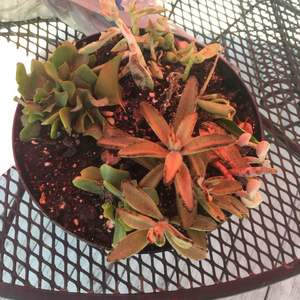
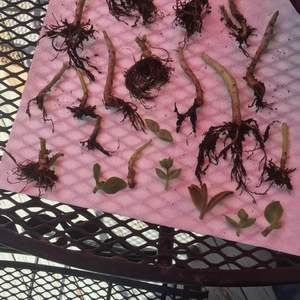

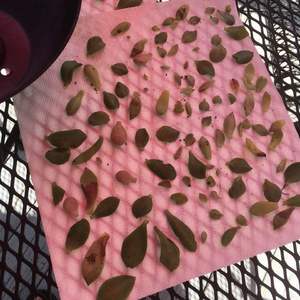




0
0
文章
Miss Chen
2018年06月15日

Description: This perennial plant is 3-6' tall, branching sparingly. The stems are terete and glabrous. The alternate leaves are up to 6" long and 4" across (excluding the petioles); they are usually divided into 3-5 pointed lobes and their margins are serrate-crenate. Leaves with 3 lobes resemble a medieval halberd because the middle lobe is much longer than the 2 lateral lobes. Leaves with 5 lobes have the shape of a maple leaf. Some of the leaves may be unlobed; they are lanceolate to ovate in shape. The leaves are glabrous and their venation is partially palmate. The petioles are long and slender. The upper stems terminate in either a solitary or small cluster of flowers.
Each flower is up to 5" across when fully open, consisting of 5 rounded petals, a columnar reproductive structure, and a green calyx with 5 oval lobes. The petals are pink to nearly white. The reproductive column consists of whorled stamens and a divided style at its tip. The throat of the flower is reddish purple. Around the base of the calyx, there are several linear bracts. The blooming period occurs from mid- to late summer, lasting about 1 month. Each flower lasts only a single day. The rather large seeds are finely hairy and irregularly shaped – they tend to be flat-sided and reniform, but this is not always the case. Their fine hairs are white or brown. The seeds are light for their size, and probably distributed by movement of water. The root system consists of a taproot. This plant spreads by reseeding itself.

Cultivation: The preference is full or partial sun, fertile soil, and wet conditions. Flowers require exposure to sunlight to open up properly. This wetland species doesn't like to dry out.
Range & Habitat: The native Halberd-Leaved Rose Mallow has been observed in most areas of Illinois, except for extreme northern Illinois and some south central areas of the state (see Distribution Map). Habitats include marshes, swamps, low areas along rivers and ponds, and soggy islands in the middle of rivers or ponds. It is not often found in highly disturbed areas, and doesn't compete well against the invasive Salix interior (Sandbar Willow).

Faunal Associations: The nectar and pollen of the flowers attract bumblebees and an oligolectic bee, Ptilothrix bombiformis. Another common floral visitor, Melitoma taurea, is oligolectic on Ipomoea spp. (Morning Glory), but it is attracted to the large funnelform flowers of other plants. Some insects feed destructively on Hibiscus spp. (Rose Mallow). Caterpillars of the butterfly, Strymon melinus (Gray Hairstreak), feed on the flower buds and developing seeds, while caterpillars of the butterfly, Vanessa cardui (Painted Lady), feed on the foliage, as do caterpillars of Pyrgus communis (Checkered Skipper). Larvae of such moths as Eudryas unio (Pearly Wood Nymph), Anomis erosa (Yellow Scallop Moth), Automeris io (Io Moth), and Acontia delecta (Delightful Bird-Dropping Moth) also feed on these plants; the latter moth is found south of Illinois, however.

Other insect feeders include the flea beetle Chaetocnema quadricollis, larvae of the sawfly Atomacera decepta, the jewel beetle Paragrilus tenuis, adults of Popillia japonica (Japanese Beetle), and some aphid species. Deer and livestock will eat the non-toxic foliage of native Hibiscus spp. readily. However, the introduced shrub, Hibiscus syriacus (Rose-of-Sharon), which is often planted in yards, is apparently more resistant to browsing by deer than the native Hibiscus spp.
Photographic Location: Along a large drainage ditch at the Windsor Road Prairie in Champaign, Illinois, where this species was introduced.

Comments: Halberd-Leaved Rose Mallow has large beautiful flowers that can be seen from a distance. Other native Hibiscus spp. in Illinois include Hibiscus moscheutos (Swamp Rose Mallow) and Hibiscus lasiocarpus (Hairy Rose Mallow). Halberd-Leaved Rose Mallow can be distinguished by its lobed leaves, as the latter two species have unlobed leaves that are oval-ovate in shape. While Halberd-Leaved Rose Mallow has hairless leaves and hairy seeds, Swamp Rose Mallow and Hairy Rose Mallow have hairy leaf undersides and hairless seeds! All of these species have similar flowers and they prefer similar wetland habitats, although Hairy Rose Mallow has a more southern distribution within the state. A scientific synonym of the Halberd-Leaved Rose Mallow is Hibiscus militaris.
Each flower is up to 5" across when fully open, consisting of 5 rounded petals, a columnar reproductive structure, and a green calyx with 5 oval lobes. The petals are pink to nearly white. The reproductive column consists of whorled stamens and a divided style at its tip. The throat of the flower is reddish purple. Around the base of the calyx, there are several linear bracts. The blooming period occurs from mid- to late summer, lasting about 1 month. Each flower lasts only a single day. The rather large seeds are finely hairy and irregularly shaped – they tend to be flat-sided and reniform, but this is not always the case. Their fine hairs are white or brown. The seeds are light for their size, and probably distributed by movement of water. The root system consists of a taproot. This plant spreads by reseeding itself.

Cultivation: The preference is full or partial sun, fertile soil, and wet conditions. Flowers require exposure to sunlight to open up properly. This wetland species doesn't like to dry out.
Range & Habitat: The native Halberd-Leaved Rose Mallow has been observed in most areas of Illinois, except for extreme northern Illinois and some south central areas of the state (see Distribution Map). Habitats include marshes, swamps, low areas along rivers and ponds, and soggy islands in the middle of rivers or ponds. It is not often found in highly disturbed areas, and doesn't compete well against the invasive Salix interior (Sandbar Willow).

Faunal Associations: The nectar and pollen of the flowers attract bumblebees and an oligolectic bee, Ptilothrix bombiformis. Another common floral visitor, Melitoma taurea, is oligolectic on Ipomoea spp. (Morning Glory), but it is attracted to the large funnelform flowers of other plants. Some insects feed destructively on Hibiscus spp. (Rose Mallow). Caterpillars of the butterfly, Strymon melinus (Gray Hairstreak), feed on the flower buds and developing seeds, while caterpillars of the butterfly, Vanessa cardui (Painted Lady), feed on the foliage, as do caterpillars of Pyrgus communis (Checkered Skipper). Larvae of such moths as Eudryas unio (Pearly Wood Nymph), Anomis erosa (Yellow Scallop Moth), Automeris io (Io Moth), and Acontia delecta (Delightful Bird-Dropping Moth) also feed on these plants; the latter moth is found south of Illinois, however.

Other insect feeders include the flea beetle Chaetocnema quadricollis, larvae of the sawfly Atomacera decepta, the jewel beetle Paragrilus tenuis, adults of Popillia japonica (Japanese Beetle), and some aphid species. Deer and livestock will eat the non-toxic foliage of native Hibiscus spp. readily. However, the introduced shrub, Hibiscus syriacus (Rose-of-Sharon), which is often planted in yards, is apparently more resistant to browsing by deer than the native Hibiscus spp.
Photographic Location: Along a large drainage ditch at the Windsor Road Prairie in Champaign, Illinois, where this species was introduced.

Comments: Halberd-Leaved Rose Mallow has large beautiful flowers that can be seen from a distance. Other native Hibiscus spp. in Illinois include Hibiscus moscheutos (Swamp Rose Mallow) and Hibiscus lasiocarpus (Hairy Rose Mallow). Halberd-Leaved Rose Mallow can be distinguished by its lobed leaves, as the latter two species have unlobed leaves that are oval-ovate in shape. While Halberd-Leaved Rose Mallow has hairless leaves and hairy seeds, Swamp Rose Mallow and Hairy Rose Mallow have hairy leaf undersides and hairless seeds! All of these species have similar flowers and they prefer similar wetland habitats, although Hairy Rose Mallow has a more southern distribution within the state. A scientific synonym of the Halberd-Leaved Rose Mallow is Hibiscus militaris.
0
0
文章
Miss Chen
2018年06月15日

Description: This perennial plant is 3-5' tall, branching sparingly to occasionally. It has greenish stems that are angular and winged. The alternate leaves are up to 5" long and 1½" across; they are lanceolate-oblong to elliptic-oblong in shape and slightly serrated along their margins. The leaves are either sessile or their bases clasp the stems. Upper stems terminate in flowerheads spanning about 1½-2" across; they are usually produced in abundance. Each flowerhead has a slightly flattened to globoid head of yellow disk florets that is surrounded by yellow ray florets. The petaloid rays of the latter florets are narrowly triangular in shape (broader at their tips than at their bases). The tips of these unusual rays are doubly notched, creating an interesting effect. The tubular corollas of the tiny disk florets are less than 1/8" across. The blooming period occurs during the autumn for 1-2 months. Afterwards, the florets are replaced by achenes that lack tufts of hair; they are distributed in part by water. The root system is shallow and fibrous.
Cultivation: The preference is full to partial sun, wet to moist conditions, and soil containing loam or silt that is relatively high in organic material. Common Sneezeweed can appear sloppy and unkempt, particularly if it is allowed to dry out.
Range & Habitat: The native Common Sneezeweed occurs throughout Illinois, where it is quite common in the central and northern sections of the state (see Distribution Map). In southern Illinois, this plant is less common or absent. Habitats include moist black soil prairies, moist meadows in wooded areas, moist meadows along rivers, moist open woodlands, soggy thickets, fens, marshes, poorly drained pastures and abandoned fields, low areas along streams and ponds, and ditches. It is not uncommon to find this plant growing within a few feet of water in both disturbed areas and higher quality habitats. Recovery from fire is poor.

Faunal Associations: Probably the most common visitors to the flowers are long-tongued bees, including honeybees, bumblebees, long-horned bees (Melissodes spp.), cuckoo bees (Coelioxys spp., Triepeolus spp.), and leaf-cutting bees (Megachile spp.). Other visitors include Halictid bees, Sphecid wasps, Vespid wasps, Syrphid flies, butterflies, and beetles. Most of these insects suck nectar, although some bees also collect pollen and some beetles feed on the pollen. The aphids Aphis vernoniae and Uroleucon tardae suck plant juices from Common Sneezeweed, while the caterpillars of Papaipema rigida (Rigid Sunflower Borer Moth) bore through its stems and feed on the pith. Mammalian herbivores usually don't feed on this plant because its foliage is toxic and bitter. There have been reports of severe poisoning for livestock that have consumed this plant, producing such symptoms as congestion of the kidneys and liver, formation of necrotic areas in the lungs, and irritation of the digestive tract. Not surprisingly, Common Sneezeweed is considered an 'increaser' in grazed meadows.

Photographic Location: The photographs were taken near a drainage ditch at Judge Webber Park in Urbana, Illinois, and in a wetland area of Weaver Park of the same city.
Comments: Notwithstanding its common name, this plant doesn't cause sneezing or hay fever during the autumn – its pollen is distributed by insects, rather than the wind. Common Sneezeweed blooms quite late in the year, providing some fall color when other plants have finished blooming. A similar species, Helenium flexuosum (Purple-Headed Sneezeweed), differs from Common Sneezeweed by having disk florets that are purple, rather than yellow, and its foliage is more soft-hairy. This latter species is native to southern Illinois.
Cultivation: The preference is full to partial sun, wet to moist conditions, and soil containing loam or silt that is relatively high in organic material. Common Sneezeweed can appear sloppy and unkempt, particularly if it is allowed to dry out.
Range & Habitat: The native Common Sneezeweed occurs throughout Illinois, where it is quite common in the central and northern sections of the state (see Distribution Map). In southern Illinois, this plant is less common or absent. Habitats include moist black soil prairies, moist meadows in wooded areas, moist meadows along rivers, moist open woodlands, soggy thickets, fens, marshes, poorly drained pastures and abandoned fields, low areas along streams and ponds, and ditches. It is not uncommon to find this plant growing within a few feet of water in both disturbed areas and higher quality habitats. Recovery from fire is poor.

Faunal Associations: Probably the most common visitors to the flowers are long-tongued bees, including honeybees, bumblebees, long-horned bees (Melissodes spp.), cuckoo bees (Coelioxys spp., Triepeolus spp.), and leaf-cutting bees (Megachile spp.). Other visitors include Halictid bees, Sphecid wasps, Vespid wasps, Syrphid flies, butterflies, and beetles. Most of these insects suck nectar, although some bees also collect pollen and some beetles feed on the pollen. The aphids Aphis vernoniae and Uroleucon tardae suck plant juices from Common Sneezeweed, while the caterpillars of Papaipema rigida (Rigid Sunflower Borer Moth) bore through its stems and feed on the pith. Mammalian herbivores usually don't feed on this plant because its foliage is toxic and bitter. There have been reports of severe poisoning for livestock that have consumed this plant, producing such symptoms as congestion of the kidneys and liver, formation of necrotic areas in the lungs, and irritation of the digestive tract. Not surprisingly, Common Sneezeweed is considered an 'increaser' in grazed meadows.

Photographic Location: The photographs were taken near a drainage ditch at Judge Webber Park in Urbana, Illinois, and in a wetland area of Weaver Park of the same city.
Comments: Notwithstanding its common name, this plant doesn't cause sneezing or hay fever during the autumn – its pollen is distributed by insects, rather than the wind. Common Sneezeweed blooms quite late in the year, providing some fall color when other plants have finished blooming. A similar species, Helenium flexuosum (Purple-Headed Sneezeweed), differs from Common Sneezeweed by having disk florets that are purple, rather than yellow, and its foliage is more soft-hairy. This latter species is native to southern Illinois.
0
0


